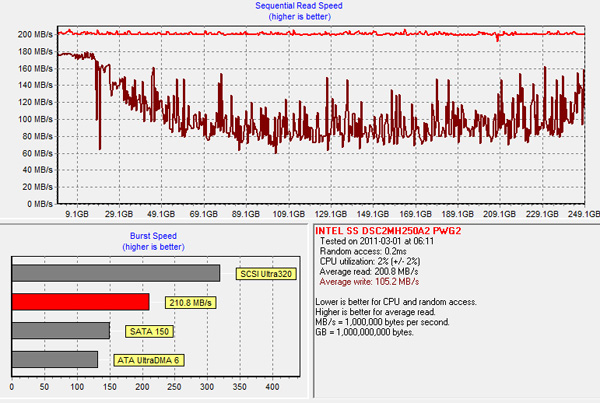The Intel SSD 510 Review
by Anand Lal Shimpi on March 2, 2011 1:23 AM EST- Posted in
- IT Computing
- Storage
- SSDs
- Intel
- Intel SSD 510
TRIM Performance
As expected, Intel's SSD 510 fully supports the ATA TRIM instruction. To gauge it's implementation I filled the 510 with data then ran a 4KB random write test (QD=32, 100% LBA space) for 20 minutes and measured performance using ATTO. I then TRIMed the entire drive by formatting it in Windows 7 and re-ran the ATTO test. The graphs below show clean, torture and and after TRIM performance.
First clean performance:

Next, after our torture session:

Once tortured the 510's performance drops as far down as 60MB/s for writes. A single TRIM pass restores performance to an almost-new state:

Worst case sequential performance isn't terrible, but worst case random write performance is pretty bad. Remember the ~50MB/s speeds from earlier? Those will drop down to ~5MB/s with an adequately fragmented drive. TRIM will recover performance but write amplification goes through the roof if you have a highly random workload. The 510 is suitable for desktop workloads, but anything more enterprise-like may be out of the question (at least not without significantly increasing the amount of spare area). I'm currently testing the 510 in a Mac to see how performance fares without TRIM over time.










128 Comments
View All Comments
AnnihilatorX - Wednesday, March 2, 2011 - link
Anand you didn't clarify very clearly what is the difference of naming between 510 series and X-25 G3.The introduction leads me to believe 510 is X-25 G3, or is it not?
Is X-25 G3 going to use 25nm flash instead, so it's another drive? If so, when is the release date of that, and how do we expect its performance compared to 510 in this review? Will the X-25 G3 uses a custom controller?
strikeback03 - Thursday, March 3, 2011 - link
As the article stated, the G3 (whatever it is officially called) will be a lower-performance part whose aim is to bring lower prices and better reliability to more mainstream segmentsMrStromberg - Wednesday, March 2, 2011 - link
So I've been waiting for quite some time now for the new intel drives since the reviews in the past about how reliable and how long life an SSD has, promising that all of this would be better with these new generation drives. Although now I am faced with the potential "problem" of a 3Gbit bottle neck in mi macbook pro and as mentioned in the review above "these next-generation SSDs not only use 6Gbps SATA, they really need it." So where does that leave me? Should a go for a cheaper older drive which might be less reliable in the long run (but nobody really knows right?) or buy a new generation drive which might be suffering from a bottleneck? I didn't really understand why the new drives really need the 6Gbit SATA to function well? Can someone please explain or give me some advice.thank you
Denithor - Wednesday, March 2, 2011 - link
Best right now would probably be an Intel G2 drive. Fast enough and very good durability.The next generation drives aren't really going to perform much better on a 3Gb SATA port than the current generation already does, plus you have the worse durability inherent in the 25nm NAND chips.
Nentor - Wednesday, March 2, 2011 - link
Wow, so Intel has a gap in it's road map and goes the 3rd party route and brings us a product that is essentially slower than a consumer product (Vertex 3) from another manufacturer.They could have gone Sandforce, why not?
mateus1984 - Wednesday, March 2, 2011 - link
http://forums.hexus.net/general-discussion/199892-...Drag0nFire - Wednesday, March 2, 2011 - link
Would love to see you run a traditional hdd through the new bench so we can see what sort of real world improvements can be expected from making the switch to an SSD...Great article. I'll be waiting for the x25-m G3. Keep on Intel about this!
wheel - Wednesday, March 2, 2011 - link
Thanks for the review Anand, but I am a little disappointed that there are a lot of synthetic benchmarks but no real world tests.By "real world tests" I mean separate tests for: booting into Windows; loading a web browser with 25 tabs of saved web page documents on the HDD; starting Star Craft and loading a map; copying a large amount of files to itself; running a batch Photoshop image transform job; starting IE6 from a stopped Windows XP Mode VM and opening a complex web page hosted on the local disk; running a intensive anti-virus scan on a specific (large) folder etc.
I know PC Mark and SysMark are meant to represent these real world test, but as individual consumers we have different usage profiles and by breaking down the results into individual tests we can better work out which drive is most appropriate for us, instead of studying the synthetic tests and making an educated guess.
Cheers,
Ian
Boogaloo - Wednesday, March 2, 2011 - link
Seconded.A lot of people are complaining about the performance of the drive, and I'd like to know how much of a difference it actually makes in real world scenarios. If this drive comes within 10 ms of a vertex 3 loading up starcraft 2, then who cares?
iwod - Wednesday, March 2, 2011 - link
If you read carefully the Anand Benchmarks does exactly just that.